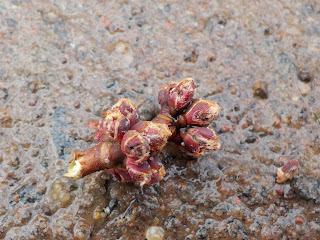The gentle sound of waves lapping at the shore tugged me toward the lake. Finally, the last sheets of ice in my little bay had melted away under the persistent caress of a warm breeze. Late afternoon sunshine prickled the back of my neck. A dead branch lay across the trail, nestled in the moldering leaf litter, victim of the winter winds. As I stooped to pick it up, a bit of color caught my eye. Zooming low above the moss was a big, fuzzy, bumble bee.
I didn’t react quick enough to stop my momentum, so the flying branch scared off the flying bee. I did get a brief glimpse of a bright orange stripe in the middle of the classic black and yellow body.
I’ve seen a bee like this before, as it was wallowing in the bounty of summer on a dazzling prairie blazing star flower. Somehow I came to identify it as Bombus ternarius, a tri-colored bumble bee. The landscape on this April day, although warm and sprouting, was a far cry from that flower-filled August field. Most bees don’t fly this late in the day, even in summer.
Bumble bees, I knew, are able to fly at colder temperatures than many other insects. Flight muscles don’t work when they’re too cold, but the limits of bumble bee flight are lower than most. In addition, they raise their body temperature above the ambient temperature using a few neat tricks.
First, bumble bees readily absorb what little sunshine peeks through the spring clouds. Then they generate their own heat by shivering muscles without flapping their wings. It can take 5 minutes of shivering to raise their muscle temperature to the required 86 degrees when the air temperature is 55. Finally, the thick fuzz that covers their bodies insulates and helps retain their hard-earned heat.
All these adaptations mean that bumble bees can be active earlier in the spring, earlier and later in the day, and in more adverse weather conditions than honey bees and other not-quite-so-hairy bees.
Still, this early in the season, I must have been in the presence of a queen. Each fall the old queen bumble bees and all the male bees die in the cold, while newly fertilized queens find a safe, underground place to overwinter. When they emerge in the spring, the queens are on their own for at least 5 weeks, until the eggs they lay become their hard-working colony.
While you may imagine that all bees nest in a hive or hollow tree like the European honey bees we use to pollinate our crops, our native bumble bees tend to house their colonies in abandoned mouse nests or other underground burrows. The burrows are sheltered from the weather and pre-insulated with grass, thistle-down, and mouse fur. Many other types of native bees are solitary and don’t form colonies at all.
It takes a lot of fuel to keep a big bumble bee buzzing, so the queens will often try to locate their nest near a food source. Near this lakeshore, the only flowers I’d seen were on willows, but elsewhere, patches of Dutchman’s breeches are said to be a draw. These oddly-shaped white flowers are consistently some of the first blooms I spot in the woods.
Not just any insect has the strength and tongue length to forage for nectar in these little pantaloon-shaped flowers, though. The queen bee grabs onto one of the white flowers, and the one next to it too, for stability. Then she’ll burrow her tongue first and then her head into the flower and angle toward one of the nectar spurs. Throughout this process, the flower’s anthers brush pollen onto her head, thorax, and forelegs. Smaller bees can’t quite pry open the petals to access the juice bar inside and they sometimes cheat by chewing a hole in the nectar spurs.
While the plant’s goal for the pollen for is for it to travel to the female parts of another flower, the queen bee uses some of it—and nectar, too—to fill a tiny honey pot inside her burrow. This food will sustain her while she broods her nest. When the pantry is stocked, she lays her eggs. After four days the eggs hatch and she feeds the larvae on more nectar and pollen while they grow. After two weeks as larvae and two more as pupae, the queen’s hard work pays off when her daughters emerge as adults—full grown and ready to work.
Queen bumble bees are especially important pollinators in early spring, but throughout the year, Wisconsin’s thirteen species of native bumble bees contribute mightily by pollinating native plants as well as crops like tomatoes, peppers, squash, cranberries, and blueberries. Their capacity to fly in cooler temperatures and ability to muscle into certain flowers make them invaluable.
But bumble bees face the same threats as honey bees: parasites, pathogens, pesticides, invasive species, climate change, and habitat loss, among others. There’s quite a buzz around bees these days, and when you learn about them, it’s not hard to understand why. They are truly the queens of spring.
For over 45 years, the Cable Natural History Museum has served to connect you to the Northwoods. Come visit us in Cable, WI! Our new phenology exhibit: “Nature’s Calendar: Signs of the Seasons” will open May 1, 2016.





